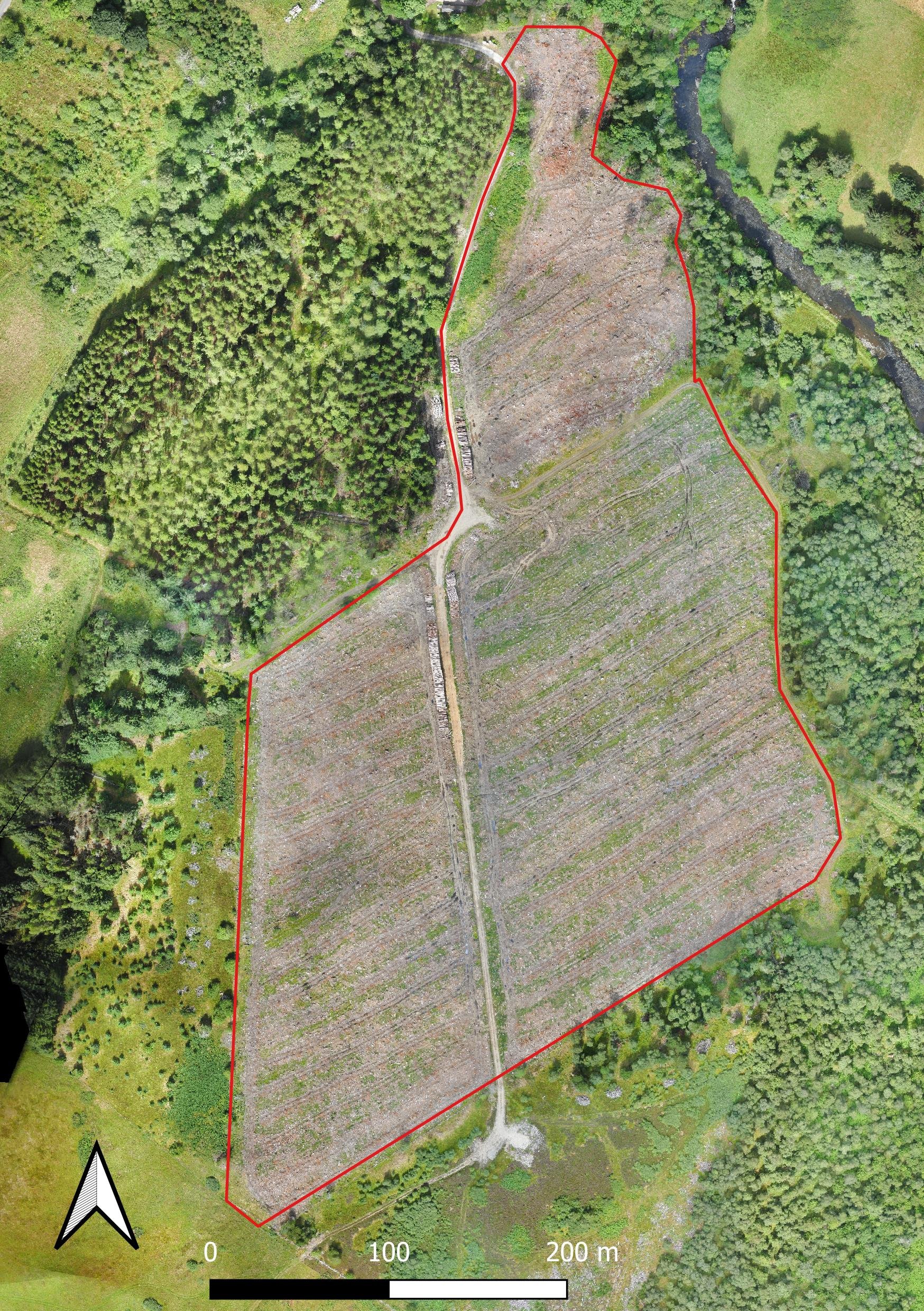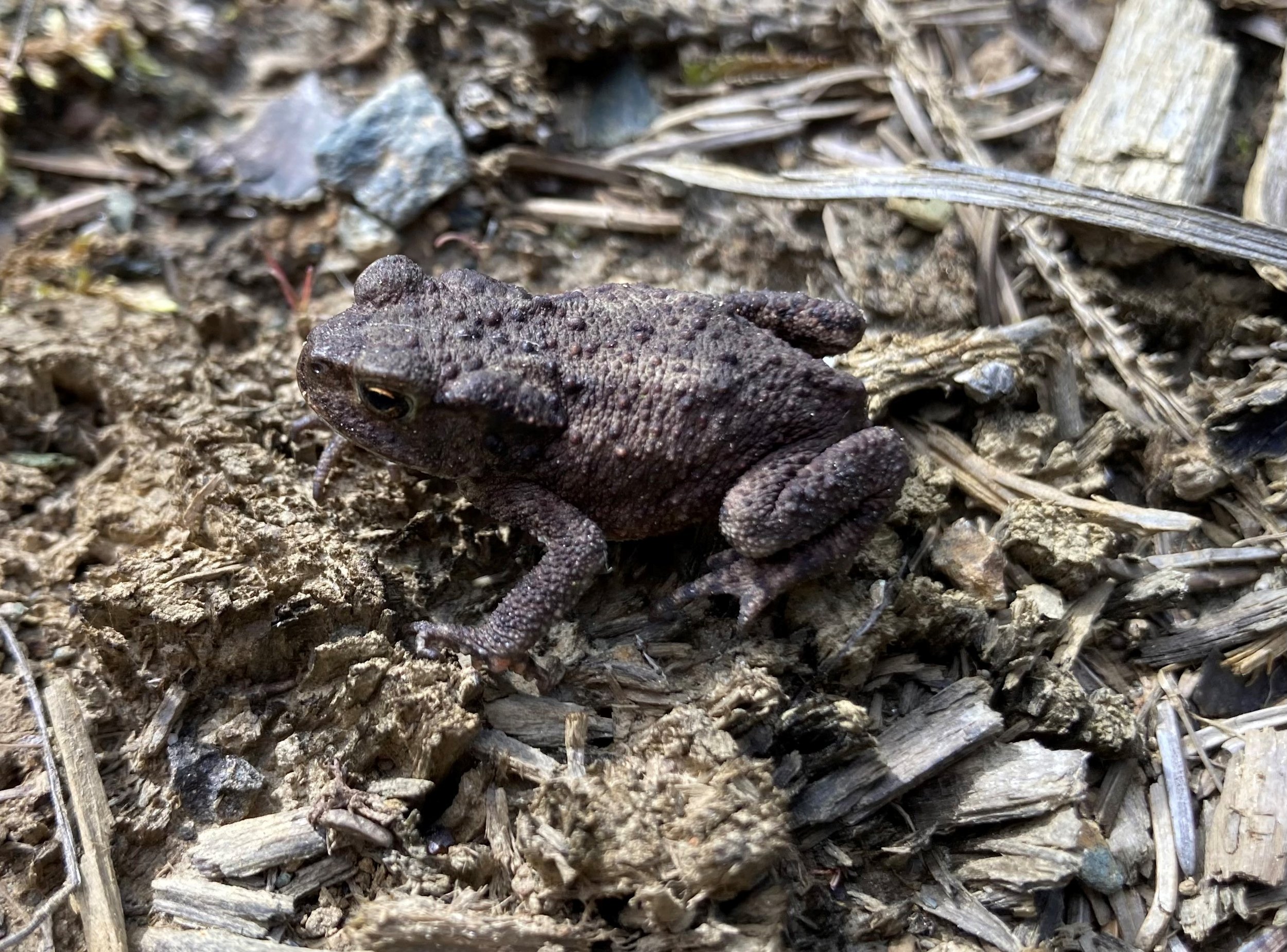The changing woodlands of Beldorney Estate
Keir Smith, Head of Forestry and Woodlands
This spring we replanted an area of forest at Beldorney, which was previously a conifer plantation, with a mix of native tree species. The area sits above a strip of Ancient woodland that runs along the River Deveron. Our hope is that the newly planted trees will serve to extend that valuable and biodiverse habitat.
Figure 1: Drone photo from July 2022 with the restock area outline in red
The replanted area, shown in Figure 1, is approximately 12 hectares. According to the records we were given by the previous owners, it was predominantly Norway Spruce planted in 1964, with an area of mixed conifers planted in 1968. When Highlands Rewilding purchased the Beldorney Estate in May 2021, these trees were ready for harvesting. Clear-felling was the only option for this area as the trees had reached what is known as terminal height, the maximum height a tree can grow to before it risks being blown over. Norway Spruce, unlike native tree species, will continue to grow beyond this terminal height and, if left, the area would have been increasingly susceptible to wind-blow in the winter storms. As a result, the timber was harvested in the winter of 2021 to 2022.
As the area is designated as forestry within the long-term forest plan for the estate, there is a statutory obligation under the Forestry and Land Management (Scotland) Act 2018 to restock. The restocking requirement is to a minimum level of 1,600 stems per hectare. Over many years the area may have successfully regenerated as native woodland from the seed source in the adjoining riparian woodland strip. However, this is a very gradual process and would not achieve the tree density requirements needed to meet the restock obligation. Another factor is that because the area has been recently growing conifers, there will be high levels of conifer seed in the soil. The conifers that would start to grow from these seeds would rapidly get taller than the native broadleaf species and shade them out.
Figure 2: Rowan naturally regenerating
Therefore, the best solution for this area was to plant it up, but where there are native trees naturally regenerating (such as the Rowan in Figure 2) they will be favoured.
When sites like this one are clear-felled, they often need to be left for up to 5 years before being replanted. This is due to the presence of pine weevils. After the trees are felled the weevils look for new food sources and cause damage to newly planted trees. We have been monitoring the weevil populations and, fortunately, found them to be low, which meant that we were confident to go ahead with the planting this spring. Had the site been left until the next planting season, the ground vegetation would have grown up further and meant more ground preparation was needed. By planting this spring we were able to use minimal ground preparation; just hand screefing, scraping the vegetation away from a small area prior to planting. This has the advantage of minimising soil disturbance.
Figure 3: One of the planted oak trees in June 2024
In total 25,500 trees were planted. This equates to roughly 2,200 trees per hectare. This is above the minimum statutory restock density of level of 1,600 stems per hectare. We will monitor for failure rates and thin the trees in places as needed. The trees were kindly provided by Trees for Life and were a mix of Oak (approximately 30%), Silver Birch (15%), Downy Birch (35%) Scots Pine (5%), Hazel (4%), Alder (4%), Willow (Grey and Goat) (3%) and Field Maple (2%). A small percentage of other species such as Hawthorn and Rowan were also planted. While Field Maple is not native to Scotland it was good to include it in the mix as it fills a similar niche to Ash (which can not currently be planted due to Ash dieback), and is likely to be more common in Scotland as a result of climate change.
The planting was carried out for us by Acer Forestry. We worked with them to design the pattern of planting to replicate natural woodland as closely as possible. For example, the spacing of the trees is varied across the site, and the species are, to some extent, grouped so that there are areas where Scots Pine will dominate and others where Oak will etc. There is also an area of a higher proportion of Oak planted near to the track, which offers the potential for sustainable timber production in the future.
The trees have been planted without tree guards. This is because the competition from the ground vegetation on the clear-fell site is currently low, and we are carrying out deer management to minimise damage. We will continue to monitor the trees at regular intervals to identify any deer damage and assess failure rates.
Figure: 4 Common Toad spotted in June 2024
While surveying the site in June to check on the trees, I spotted this Common Toad. Hopefully a sign of the positive impact on biodiversity compared to the previous conifer plantation.
We are currently working on a new long-term forest plan for Beldorney estate and will be putting our plans out to consultation with the local community in the coming months.
If you would like to hear more about our different sites, sign up to our newsletter to get on the ground updates.




